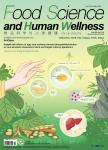版权所有:内蒙古大学图书馆 技术提供:维普资讯• 智图
内蒙古自治区呼和浩特市赛罕区大学西街235号 邮编: 010021

作者机构:College of Food Science and Technology, Yunnan Agricultural University Yunnan Provincial Key Laboratory of Precision Nutrition and Personalized Food Manufacturing, Yunnan Agricultural University National Research and Development Professional Center for Moringa Processing Technology, Yunnan Agricultural University Engineering Research Center of Development and Utilization of Food and Drug Homologous Resources, Ministry of Education, Yunnan Agricultural University Yunnan Provincial Engineering Research Center for Edible and Medicinal Homologous Functional Food, Yunnan Agricultural University School of Tea and Coffee, Puer University
出 版 物:《Food Science and Human Wellness》 (食品科学与人类健康(英文))
年 卷 期:2024年
核心收录:
学科分类:1004[医学-公共卫生与预防医学(可授医学、理学学位)] 100403[医学-营养与食品卫生学] 10[医学]
基 金:supported by the Basic Research Project of Yunnan Provincial Science and Technology Department (202201AT070262) the Project of Yunnan Province Food and Drug Homologous Resources Functional Food Innovation Team (A3032023057) the Yunnan Province Ten Thousand Plan Industrial Technology Talents Project (YNWR-CYJS-2020-010) the Yunnan Province-City Integration Project (202302 AN360002)
摘 要:Obesity has brought great challenges to global human health, and how to effectively prevent and control the occurrence and development of obesity has become an urgent problem. The role and mechanism of 4-[(α-L-Rhamnosyloxy) benzyl] isothiocyanate (MITC), an active ingredient of Moringa oleifera Lam., in the regulation of lipid metabolism have not been comprehensively investigated. In the present study, we investigated the mechanism of MITC in inhibiting lipid accumulation in mice fed with a high-fat diet (HFD) in terms of both lipolysis and central appetite regulation mediated by the gut microbe–gut–brain axis. MITC enhanced the characteristic indices associated with HFD mice and also promoted adipocytolysis and brown fat thermogenesis. Moreover, MITC was observed to improve leptin resistance, modulate the composition of gut microbiota such as Ruminococcaceae, Parasutterella, and Acetatifactor, promote 5-HT secretion, further enhance the secretion of glucagon-like peptide-1 (GLP-1) and peptide tyrosine-tyrosine (PYY) to activate peroxisome proliferator-activated receptor (PPAR) signaling in the hypothalamus, and modulate feeding behavior to inhibit lipid accumulation in HFD mice. These data suggest that MITC supplementation can help to alleviate obesity or obesity-related diseases.